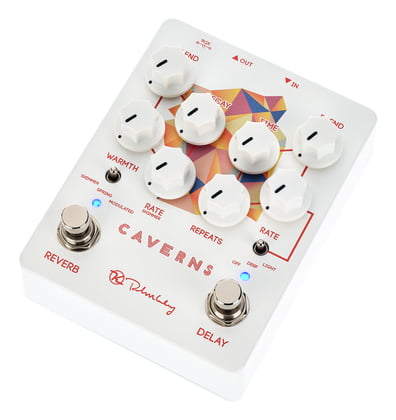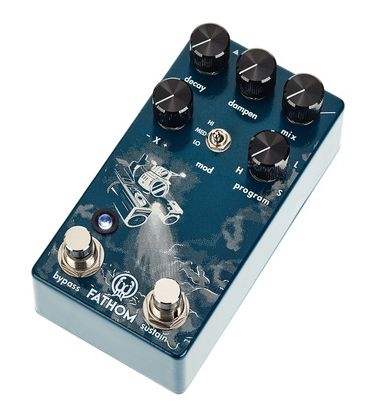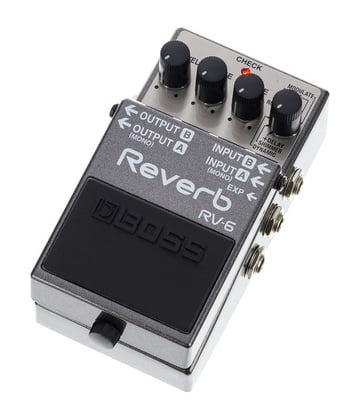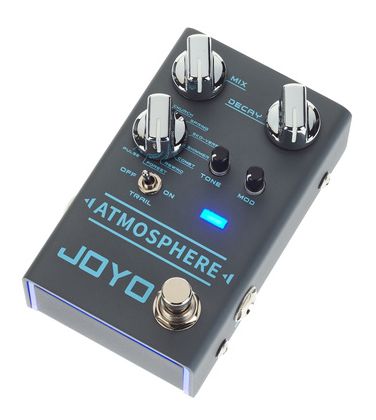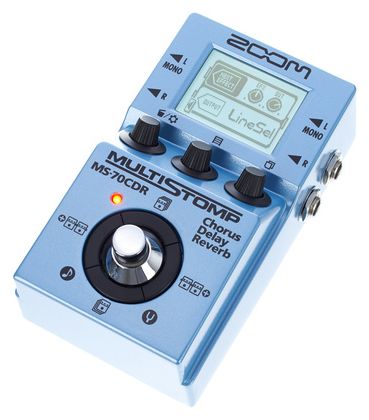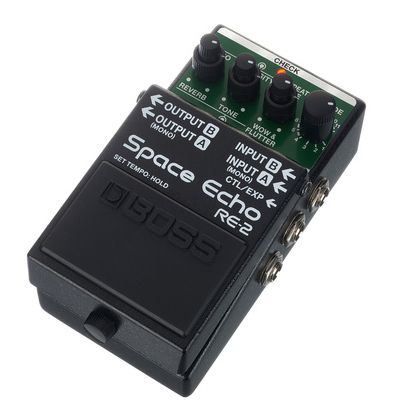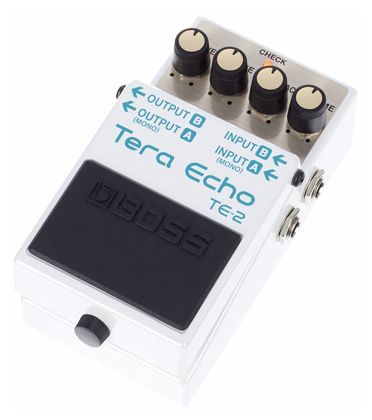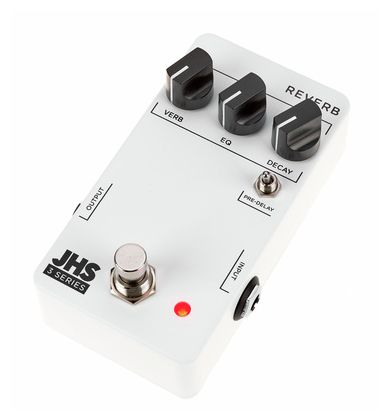Let’s talk about various pedals that we believe are great for your ambient guitar.
Apart from creative chord progressions, delicate fingerpicking, and scintillating solos, your guitar can do much more. While distortions, crunch tones, and a definitive clean sound are something you cannot be without as a guitar player, many uncharted territories need to be explored.
This is where ambient music comes in. Deviating from traditional beats, time signatures, and structure, ambient music can create a mesmerizing atmosphere to serenade your audience.
This post aims to help you pick the perfect Reverb, Echo, and Delay pedals to set the tone for your next ambient concert.
The 11 Pedals For Ambient Guitar 2024 To Consider
1. Keeley Caverns V2
The Keeley Caverns is a multitasking pedal that delivers some fascinating results.
Keeley Electronics is a big name when it comes to effect pedals. Being one of the best in the business, KE specializes in compressors, boost pedals, distortion, overdrive, chorus, modulation effects, delays, echos, reverbs, and auto wah pedals, among others.
Why get two separate pedals for delay and reverb when you can get a two-in-one unit that covers both these effects effectively and efficiently without taking much space or your pedal board? In addition, the Keeley Caverns’ rugged chassis is built to last, so you’ll enjoy it for years to come.
Key Features:
- Footswitches
The Keeley Cavern’s layout is divided into two sections, one for reverb and the other for the delay. Each section gets a dedicated footswitch. The footswitches power the unit on/off and decide whether the delay/reverb effects switch off directly or taper off naturally when the switch is pressed.
- Reverb Controls
Firstly, on the reverb side of things is a switch that can select the reverb type. The options you get here are “Shimmer,” “Spring,” and “Modulated.” There are 4 knobs that control the various parameters of the selected reverb type.
The “Blend” knob controls the ratio between the dry and wet signal. The “Decay” knob controls the reverb length from subtle to endless. The “Warmth” knob controls the tone of the reverb effect between bright and dark settings.
- Delay Controls
You’ll also find a switch on the delay side marked “off,” “deep,” and “light.” On the off setting, there is no modulation, while in the deep setting, the modulation is most intense. The delay effect has a similar layout to the reverb side, as you also find 4 different knobs here.
The “Blend” knob controls the ratio between the original signal and the delay effect. The “Time” knob lets the user select the delay time between 30 to 650 milliseconds. A “Repeat” knob controls the feedback or the intensity of the delay’s repeat.
Pros:
The Keeley Caverns is, in fact, two effects pedals packed in one. You get dedicated controls for tinkering both the delay and reverb sections independently. Both sections allow you to choose between multiple types with ample controls to dial down the available parameters just the way you want them.
Cons:
While knobs are a great way to dial in your sound, however, when it comes to the delay effect, it’s always handy to have a tap tempo footswitch which you can easily hit with your foot in a live situation instead of having to bend down to set this parameter. If you’re someone who doesn’t like too many controls, you may opt for a single-effect pedal.
2. Walrus Audio Fathom
Here’s a very cool-looking reverb pedal from the Walrus product line.
Dubbed the “multifunctional” reverb pedal, the Walrus Audio Fathom is a useful pedal to have around. Looking at it, one can tell that it has a comprehensive layout and brings many adjustable parameters to your fingertips. The pedal has dimensions of 1.39 x 2.6 x 4.77 inches.
Furthermore, things are not as plain as they seem since there are plenty of hidden features brought to life by some multipurpose controls on the Walrus Audio Fathom’s interface. You’ll see a deep-sea diver on the front panel, which is fitting because some of the pedal’s reverb effects seem to be coming from underwater.
Key Features:
- Decay, Dampen, Mix
The Walrus Audio Fathom has a row of three control knobs at the top. The “decay” knob is used to adjust the reverb length. Moving it to the left reduces the length, while turning it to the right increases the length of the reverb.
The “dampen” knob acts as an equalizer control to change the reverb’s tone. Turning to the left darkens the sound, while turning to the right brightens it.
- Mod, Program
The second row has controls to adjust three different parameters. The “program” knob determines which type of reverb signal is selected. There are four options to choose from, including “Hall,” “Plate,” “Plate,” and “Sonar” (all denoted by their first letters on the knob). The hall setting is wide and spacious, with a high-frequency roll-off in its decay.
Plate mimics the reverb generated by old plate reverb units of the past, while Lo-fi allows you to add warmth to the reverb or have it sound like an AM radio. Sonar brings some octave-based sorcery to the fore. You can get three variations of each selected program through the mod switch, with includes high, medium, and low options.
- X
The mysterious “X” knob also reacts differently in each program setting. For Hall and Plate, it varies the pre-delay or the time it takes for the reverb to come into effect. In Lo-Fi mode, it selects the width of the filter, and in Sonar mode, the X knob controls the ratio of higher and lower octaves. At the 12 o’clock setting, you get equal parts of both.
- Footswitches
The pedal features two footswitches labeled “bypass” and “sustain.” The bypass switch is multifunctional as apart from its regular duties of turning the unit on or off; it can change the behavior of the Walrus Audio Fathom. For instance, if you wish to activate the reverb effect temporarily, you can press and hold the bypass button.
Letting go will disable the temporary reverberation. Finally, the “sustain” footswitch can be long-pressed to add sustain to the decay to create a surround sound-like ambiance.
Pros:
The Walrus Audio Fathom gives you plenty of variables to play with, including four program settings with three intensity settings for each, 3 knobs to control the character of the reverb tone, and an X knob that adjusts specific parameters of each selected program.
In addition, the multipurpose bypass button is very smartly engineered, and the mix knob, in particular, creates some great reverb representations.
Cons:
While the Walrus Audio Fathom is a decent reverb unit, there may be cheaper alternatives in the market that create similar ambient results at a slightly lower cost. In addition, the four program settings sound a bit digital. Finally, having a feature to save and recall user presets would be beneficial.
3. Boss RV-6
When it comes to delivering state-of-the-art effects pedals, few can compete with Boss.
Being a frequently used effect, it’s always great to have a decent reverb pedal on your pedal board, so you’re ready to go when the situation presents itself. Thankfully, the Boss RV-6 has you covered, as it measures just 2.37 by 2.87 by 5.12 inches and hardly takes any space on your board.
You get plenty of controls and modes on this little magic box, and the good thing is that it’s built like a tank, so the chances of you damaging it while stomping hard on it out of excitement on a live stage are very slim. Also, the good news for musicians who freak out when they see a clutter of wires is that the pedal can run on batteries too.
Key Features:
- Control Knobs
The pedal has a simple layout with 4 control knobs. The first knob labeled “E.Level Knob” controls the volume of the reverb effect. You can dial it up to make the effect cut through the mix. The “Tone” knob is an equalizer of sorts and adjusts the frequency response of the simulated reverb reflections.
The third knob is the “Time” knob. As you would’ve guessed, the time knob sets the length of the reverb or how long the reverb effect stays after a note ends.
- Modes
The most important knob is the “Mode” knob. It can be used to toggle between 8 different modes, including +Delay, Shimmer, Dynamic, Room, Hall, Plate, Spring, and Modulate. The first mode is the +Delay, which combines the delay and reverb effects.
The Shimmer mode has much more character and adds a sparkly, fantasy-like reverb which sounds very immersive. In the Dynamic mode, the reverb is automated and reacts to the incoming signal accordingly by delivering depth without causing any blurriness to the texture of what is being played.
- Miscellaneous Features
The pedal’s footswitch can switch the unit on or off. You’ll also notice a screw that can be loosened to reveal the battery compartment under the footswitch. The Boss RV-6 is powered by a 9V battery or an AC adapter that can be plugged into the pedal’s back panel.
Finally, a “Check” led indicates when the unit is on and dims or switches off completely depending on the juice in the battery.
Pros:
The Boss RV-6 has plenty of controls to set parameters just the way you want for the perfect manifestation of reverb. There are eight different modes to choose from, and in each setting, you get a volume, tone, and time knob to dial the right level and type of reverb for the situation.
Cons:
Although there are plenty of modes, perhaps there is not enough distinction between different effects to keep you interested. So, you’ll probably be using only a few of the total available options. The shimmer effect stands out from the rest; however, it would’ve been great if the ratio between reverb and shimmer could have been altered.
4. Joyo R-14
The Chinese manufacturer by the name of Joyo has earned its chops over the years.
The Joyo R-14 not only has a ton of options for producing those wide-sounding, immersive ambient sounds to serenade your listeners, but it does so by looking extremely flashy and illuminated. In addition, in the R-14, you get a quality “Atmosphere” reverb pedal with solid controls, which hardly costs anything.
Here’s a reverb pedal that will turn some heads when you use it on stage under dim lights. The Joyo R-14 is surrounded by strategically placed LEDs, making it stand out on your pedal board. The blue LEDs follow the same theme as the text on the user interface.
Key Features:
- LEDs
The Joyo R-14 looks cool when switched on, thanks to the 2 LED strips on the back and front of the pedal, which have an electric blue glow like the power LED on top of the interface. These lights can be programmed to stay off, stay on, or be synced with the footswitch. This can be done through the LED switch on the underside of the R-14.
- Knobs, knobs, and more knobs
There are two large silver-colored knobs on the interface labeled “Mix” and “Decay.” As you may be familiar with these two controls found on most reverb pedals, the mix knob alters the ratio between the wet and dry signal while the decay controls the reverb’s time.
There are two smaller black colored knobs on the interface marked “Tone” and “Mod.” Through the tone knob, the output signal can be darkened by moving anticlockwise and brightened by moving the other way.
- Effects Knob
The effects knob is the reason why someone will choose to buy the pedal. All the magic happens here as you get whopping 10 different types of reverbs. Starting with the first few settings, you get a simulation of the huge “Plate” reverb units and classic “Spring” tanks of the past.
Next, you find the “Church” setting, which simulates a large hall feel. The “Eko-Verb” is another interesting effect that combines echo with a repeated reverb for some exciting applications. The “Shimmer” setting produces a brightly spacious ambiance that, combined with the mix control, can create intoxicating effects.
The “Comet” setting manifests like a space-based reverb as if a playful comet is orbiting around you. When the knob is set to “Rewind,” the effect sounds like an old tape being rewound and has a subtle difference compared to the previous setting.
The “Forest” mode feels like the reverb sound spreads out sideways and behind you for a surround-type feel. Finally, the “Pulse” mode is almost like a tremolo effect.
Pros:
The people of Joyo have tried to equip the R-14 with every fathomable reverb type and have somewhat succeeded in their implementation. The R-14 offers 10 different reverb types, each of which has 5 parameter controls aiding you in getting close to how you wish to sound. The electric blue light looks unique, and the trail switch is an important feature.
Cons:
Some of the modes controlled through the effects knobs sound quite similar. An untrained ear may not be able to pick the difference, but a seasoned veteran will surely notice this and perhaps choose to go in another direction. The build quality is a bit flimsy, as it feels like the unit will fall apart after a few stage performances. The reverb effects lack a bit of clarity.
5. Donner Yellow Fall
Donner has a barrage of colorful pocket-sized pedals in its “Mini” series.
The series includes the likes of the ABY Box, Black Tuner, Blue Chorus, Blue Compressor, Blue Modulation, Blue Modulation, Green Noise Gate, and of course, the Yellow Fall delay pedal, among many others. All these devices measure about 4.7 x 3 x 2.5 inches, so that you can accommodate plenty of Donner pedals on your pedalboard.
The Donner Yellow Fall unit is billed as an analog delay pedal. However, the more tech-savvy musicians may do some research to find out that the chip used in the internal circuitry is an analog emulation. Nonetheless, the pedal sounds great and has several applications in different music genres, including jazz, rock, pop, and more.
Key Features:
- Feedback
The Donner Yellow Fall pedal has two tiny knobs that control different parameters. The feedback knob controls how many times the echo effect is heard. When the knob is lowered, you’ll hear one solid feedback, and the effect will fade away.
As the feedback value is increased, however, the number of echoes, you hear increases too. At the far right setting, you’ll get endless/infinite echo.
- Echo
The second smaller knob on the Donner Yellow Fall pedal is marked “Echo” and acts like a mix control. You can control the intensity of the echo effects compared to the audio signal fed through the pedal.
For example, if the knob is turned to the far left, all you’ll hear is the dry signal, while as you move to the right, more of the wet signal will be heard in comparison.
- Time Control & Footswitch
The largest knob located in the center of the pedal controls the “Time” or, in simpler terms, the time it takes for the delay to come into effect when a note is played. If the Time knob is turned towards the left, the delay will be triggered as soon something is played. As you turn the knob clockwise, the gap between the original signal and the echo effect increases.
Pros:
Being a member of Donner’s “Mini” series, the Yellow Fall is extremely tiny and portable. Built like a tank, the knobs are solid, and so is the footswitch. For musicians who aren’t tech-savvy, a unit like the Yellow Fall, with its simplicity and minimal controls, is a God send. A pedal that is priced so low can be worth buying just for experimentation’s sake.
Cons:
The more technical musician may want more controls to dig deep and get that perfect echo effect going. The time control on the pedal is a bit limited as some more expensive pedals may offer an echo time of over 600 milliseconds. Furthermore, when the feedback value is increased, the echo effect becomes very shrill after a few iterations.
6. Zoom MS-70CDR Multi Stomp
Zoom is a brand that exudes innovation and out-of-the-box thinking.
As a guitar player, I’ve experienced several effects processors and pedals by Zoom, and not once have I been disappointed. The think tanks at Zoom seem to do considerable market research before finalizing their products to ensure they gain acceptance and popularity among the masses.
Most Zoom pedals are heavily packed with features and are built to last. Not only that, but the company has also always given special attention to the prices of these pedals to make them available to a more widespread audience. You’ll be surprised to see how accomplished the Zoom MS-70CDR is.
Key Features:
- Display and Parameter Controls
The MS-70CDR has an LCD that shows the selected effect in the form of virtual pedals. Once selected, each pedal displays a tiny strip below with different buttons. Each of these buttons can be accessed by the three parametric knobs below the display that can be pressed to select menus and rotated to change values.
The primary responsibility of all knobs is to change different parameters; however, some other features can also be managed just as easily.
The first knob can delete or change the order of different effects in the effects chain. The second knob can choose or save presets for recall when needed. Some effects have several pages within them for manipulating different variables. The third knob can navigate through these pages with ease.
- Footswitch & Navigation
The footswitch on the MS-70CDR is multifunctional. Apart from its obvious duty of turning the unit on/off, the footswitch can be long-pressed to activate the built-in chromatic tuner. Furthermore, when in tap tempo mode, you can tap the footswitch multiple times to set the tempo of different effects.
Four cursor buttons surround the footswitch in a ring and make navigation through different menus and submenus a cinch.
- Effects
The Zoom MS-70CDR is loaded with an astounding number of effects. The 86 effects are categorized into 4 headings: chorus, delay, reverb, and filter. So apart from various choruses, delays, and reverbs, you get modulation effects like flangers, tremolos, pads, synths, and much more. The pedal comes with 30 factory presets, and the rest of the memory can store customized user presets.
Pros:
The MS-70CDR offers 86 effects in one unit at a price that boggles the mind considering what the pedal is capable of. You get a plethora of choruses, delays, reverbs, and interesting effects like tremolos and flangers. There’s also a built-in tuner which is extremely handy at times.
The layout of control is nicely engineered as the cursor keys, and parameter knobs make everything so easy. Furthermore, since so many effects are housed in a single unit, think of the space you’ll save on your pedal board.
Cons:
If you’re someone who is used to a simple one-effect pedal, the MS-70CDR may not be for you. This offering by Zoom allows you to dive deep into multiple menus and submenus to get what you need. If you like everything on a single layer without complications, then perhaps you could go for three single pedals for ease of usage.
7. Wampler Faux Tape Echo V2
Wampler pedals are handmade in America and receive special attention to ensure unmatched quality.
You may be more familiar with the Wampler Faux Tape Echo V1, the black-colored predecessor of the second version. As all successful companies do, Wampler took notes on what was great about version 1, brought all those features back, and ditched aspects that weren’t particularly great.
In doing so, the Wampler Faux Tape Echo V2 has become a complete unit with a layout that is easy to understand and access. Some of the sections and switches in the older version have been replaced with user-friendly knobs, while the V2 comes with creatively engineered controls.
Key Features:
- Footswitches
The Wampler Faux Tape Echo V2 has two footswitches on the interface. The first switch is labeled “Bypass,” which can power the unit or allow the audio signal to bypass the unit unchanged and unaffected. The second footswitch is marked “Tap Tempo” and, when tapped, functions by overriding the previously set tempo.
- Rate & Depth
Starting from the far left, the “Rate” knob can be used to control the time it takes for the modulation to come into effect after the audio signal. As you move the knob to the right, the response time becomes faster. The “Depth” controls how deep the modulation effect will be. The depth increases as the knob is moved to the right. Using these two controls together gives fascinating results.
- Tone & Repeat
The “Tone” knob comes in handy if you want to change the characteristics of the delayed signal. The knob gives you a range of sounds from warm to dark to bright and shiny. You’ll get more brightness as the knob is turned clockwise.
Finally, the “Repeat” knob is essential in creating mesmerizing oscillation effects and wide spacious ambient sounds. Repeat controls the behavior of the delay once the initial note is played.
- Delay Mix & Delay
The “Delay Mix” and “Delay” controls can be combined with the “Repeat” feature to get the most out of the Wampler Faux Tape Echo V2. In addition, the delay mix decides how much of the delayed signal is heard with respect to the original input signal. Finally, the delay knob controls the delay time, which can be set up to 800 milliseconds as the situation demands.
- Subdivisions
Smack dab in the middle of the Wampler Faux Tape Echo V2 is a subdivision switch that was nonexistent in the previous version. The switch allows the user to choose between quarter, eight, dotted eight, or triple notes by changing the speed of the delay on the fly. The feature is great if you want to experiment with different echo speeds in different song sections.
Pros:
The Faux Tape Echo V2 is a big improvement from the previous version, as Wampler has equipped it with plenty of controls to encourage experimentation and finetuning. Furthermore, the subdivision feature is unique and helps you change delay timings on the go without digging deep when the need arises.
Cons:
The Wampler Faux Tape Echo V2 isn’t battery-powered and doesn’t come with an adapter either. Furthermore, it is a bit more expensive than the pedals we’ve covered thus far, which means that there are several cheaper options out there with similar capabilities. Finally, the internal circuitry is a bit dicey as some users have complained that the unit becomes noisy over time.
8. Boss RE-2
Boss’s innovative approach and unique strategy-making set it apart from the rest.
The RE-2 is a testament to the creativity that Boss brings to the table. Measuring 2.37 by 2.87 by 5.12 inches, the pedal merges two essential effects that are must-haves for any successful guitarist. This means that on a single pedal, you get cleverly engineered multipurpose knobs that control the parameters of both Delay and Reverb.
If you’re not impressed yet and are unsure about how the Boss RE-2 performs in both situations, the think tanks at Boss have you covered. All you need to do is visit the “Tone Pedia” section on the pedal’s webpage, and you’ll be directed to an interactive digital representation of the RE-2 to see firsthand what it’s capable of.
Key Features:
- Power
The unit can be powered with a power adapter from the PSA-100S series (sold separately) through the 9V port at the back of the unit. The “Check” LED lights up when the pedal is turned on. The RE-2 is also battery-powered, so the LED can brighten up or dim down to show the current status of the batteries.
- Concentric Knobs
The Boss RE-2 features three concentric controls. Each control has an inner knob and an outer knob controlling different parameters. For instance, the first concentric knob has an inner dial that controls the volume of the echo and an outer knob that controls the volume of the reverb effect.
Next to it is a similar-looking dual knob that controls the intensity of the echo and adds oscillation to the sound. The outer ring labeled “Tone” helps cut high and low frequencies to darken or brighten the reverb sound.
- Repeat Rate/Wow & Flutter
The inner knob marked “Repeat Rate” controls the tape speed. You can vary the gaps between the echoes by rotating this knob. The “Wow & Flutter” effect recreates the fluttering effect that may occur due to tape slippage or varying tape speeds.
Rotating this knob to the right will increase the wavering effect.
- Mode
When it comes to the different modes, the Boss RE-2 takes inspiration from the larger RE-201 unit and the later-released dual footswitch version of the RE-20. The modes can be selected using the aptly named “Mode” knob, labeled from 1 – 11. The idea is to combine different heads, reverb, and echo effects.
To start with, the first setting selects the first playback head. The second and third heads have twice and thrice the delay time and can be selected through modes 2 and 3, respectively.
Pros:
The RE-2 has a lot going for it, as the people at Boss have managed to load it with so many features while keeping it confined to a single footswitch unit. The interface real estate has been utilized innovatively by making use of easy-to-comprehend concentric knobs to avoid much clutter. In addition, the mode control unleashes 11 different effect combinations giving way to endless possibilities.
Cons:
While the mode feature has several applications, there’s so guide text or a tabular representation that tells the user about the combinations in each mode, so you’ll either have to memorize the manual or judge by ear.
Also, the RE-2 may be too complicated for beginners who just want to stick to the basics and need limited controls to keep things simple.
9. Boss TE-2 Tera Echo Pedal
A fun fact about the Boss TE-2 Tera Echo Pedal is that it’s the 100th pedal made by Boss.
Boss’s R & D team is always up for a new challenge. As a result, every new effects unit released by the brand has something exciting and unheard of to offer. No wonder Boss stays ahead of its competition and has a wide audience worldwide. The Boss TE-2 Tera Echo Pedal is one device that brings a new dimension of creativity to your pedal board.
The TE-2 is part of Boss’s Multidimensional Processing (MDP) series. The pedals from this series can take the incoming guitar signal, break it down into parts, and process it according to to pick attack, playing intensity, and several other variables. You’ll notice that it takes up to three different pedals to serve the ambient sounds the TE-2 can dish out.
Key Features:
- E-Level
The TE-2’s layout is quite simple and user-friendly. Starting from the left, you’ll find the “E-Level” knob. If you wish to increase or decrease the volume of the echo, you can do so by fiddling with this control. The level increases as you move the knob clockwise.
- Tone Knob
Next in line is the “Tone” knob that acts as a mini equalizer and helps roll off the higher or lower-end frequencies depending on the requirement. When the knob is moved, the effect’s sound becomes brighter and more trebly. Moving the knob in the other direction darkens the tone.
- Feedback
The “Feedback” knob is programmed to increase or decrease the decay of the echo effect. At times you need the echo to die down quickly, in which case you’ll need to move the knob control in an anticlockwise direction. Other times you’ll wish that the echo feedback lingers on. This can be done by moving the knob in the clockwise direction.
- S-Time
“S-time” stands for spread time. This is where the pedal gets its magic. Depending on how lightly or aggressively you play, the S-time settings will have different manifestations. Turned to a lower setting, abrupt transients that are instantly muted will sound like they have reverberations.
An aggressive strum will give off a combination of reverb and echo. With palm-muted strings, you’ll hear some fluttering. All this wizardry is delivered by just one knob control. Cranking the control will conjure up some ambient modulations and a filter effect, so the possibilities are endless as you experiment with the S-time control on the Boss TE-2.
- Footswitch
The footswitch is what turns the unit on or off. However, a useful feature of the footswitch is that if you play something and push down on the switch, the effect will be held until you let go. There are a lot of creative ways to make use of this.
For instance, you could play a chord progression with the S-time control set past noon and press down on the footswitch to let the ambiance linger while you play a gentle solo over the sound. Again, there are a lot of creative ways to utilize this option.
Pros:
The Boss TE-2 is very strongly built and has solid controls. The interface is easy to use without too much clutter. Being a pedal from the Multidimensional Processing series, the TE-2 processes the guitar signal uniquely to deliver several different ambient sounds simultaneously. In addition, the long press foot switch feature enables you to layer different effects for soloing.
Cons:
While the S-time feature is unique and useful, having a few more controls would be beneficial to change different aspects of the S-time knob control. Furthermore, the pedal lacks the ability to save multiple presets, which could come in handy if you’re on stage and want different echo settings in different songs.
10. Caline CP-41 Ghost Rain
If you’re looking for an effects pedal that combines a couple of effects while keeping things simple, the Caline CP-41 is worth checking out.
The Caline CP-41 “Ghost Rain” reverb delay looks great with funky pink ghost theme graphics over a white background. Measuring 3.7 by 4.7 by 1.4 inches, the pedal is a bit bulky compared to some of the other single footswitch models out in the market.
The Caline company has designed the CP-41 to ensure that the pedal is very simple and has everything a beginner-level musician may need to start experimenting with some reverb and echo combinations. Also, the pedal is very economically priced, considering its capabilities, so you’ll get great value for your money.
Key Features:
- Echo
The “Echo” knob is actually the mix control so that you can select the intensity of the effect compared to the original signal. Turning the knob towards the right will give you more of the wet signal. Turning to the left reduces the echo effect and enhances the original audio signal.
- Feedback
With this control knob, you can adjust how often you’ll hear the feedback after a note is played. For example, turning the “Feedback” knob to the far left will eliminate the feedback completely. On a slightly higher setting, you’ll perhaps hear just one repetition. However, the number of repeats will increase as you move toward the right side.
- Time
The “Time” knob controls the speed of the delay. You can set the knob so the echo effect may start as soon as you play. You could also program it to start after a short pre-delay pause. Echo pedals offer different time variables. The CP-41 offers a variable range of 25 to 600 milliseconds.
Pros:
The Caline CP-41 is more suited for beginner or intermediate musicians as it has a simple layout and not too many controls, which would make it difficult to understand. The pedal is extremely cheap and performs well, considering its price. The construction is solid, and many echo effects can be cooked up by combining the three control knobs on the unit.
Cons:
Something to note here is that the CP-41 is more of a delay pedal than a reverb pedal. Therefore, you’ll only hear the reverb effect when the echo is turned down. Furthermore, it’s always helpful when pedals with time-based effects have a tap tempo option which guarantees more accuracy and ease of use during liver performances which the CP-41 lacks.
11. JHS 3 Series Reverb Pedal
This particular reverb pedal belongs to a family of pedals released by JHS under the JHS 3 Series.
The JHS 3 series answers 2 major questions. First, can a pedal be under 100 dollars? And second, can a pedal be so simple that anyone can use it easily? The answer to both these questions is a resounding “Yes!” according to the people working at JHS. The JHS 3 series offer multiple pedals for the modern-day musician.
This particular series from JHS includes seven different pedals that cover all major effects, including Overdrive, Delay, Chorus, Distortion, Compressor, Reverb, and Fuzz. Every single pedal looks exactly the same and comes in a white metallic exterior with a single footswitch, a couple of I/O options, and just three knobs that control the relevant parameters, hence the name JHS “3” Series.
Key Features:
- Verb & EQ
The JHS 3 Series Reverb Pedal has a very simple control setup. The interface has just three control knobs. Starting from the left, the first knob is the “Verb” knob. This changes the intensity of the reverb effect. You can set the reverb to sound like a small room environment to a spacious large hall ambiance depending on the need of the hour. Next to the verb knob is the “EQ” knob.
- Decay & Pre-Delay
The third knob on the JHS 3 Series Reverb Pedal adjusts the “Decay” of the reverb. Moving the knob to the left will shorten the reverb trail while turning it to the right will decrease the trail, which means that the reverb effect will diminish quickly. You’ll also find a “Pre-Delay” switch on the JHS 3 Series Reverb Pedal.
When the switch is turned up, it creates a short pause between the audio signal and the time the reverb comes into effect.
- Inputs & Outputs
The I/O jacks are as simple as the pedal’s layout. You’ll find a single quarter-inch jack on the left for the input signal of your instrument and a quarter-inch jack for the unit’s output which can be routed to an amp.
There’s also a power jack on the back of the unit, whereas the power supply needs to be purchased separately. The JHS 3 Series Reverb Pedal doesn’t run on batteries.
Pros:
The JHS 3 Series Reverb Pedal is extremely affordable as it’s hard to come by an American-made pedal with such capabilities under the 100-dollar mark. The build is solid, and the unit measures just 1.22 by 2.38 by 4.42 inches and doesn’t take much room on the pedal board.
If you’re a beginner/intermediate player or just a fan of simple pedals, the JHS 3 Reverb pedal fits the bill perfectly.
Cons:
While very fancy in its appearance, the pre-delay switch doesn’t do much and is too subtle to be excited about.
Also, since the JHS series is all about simplicity, if you’re a fan of multiple knob controls and tinkering with every little aspect of an effects pedal, perhaps you won’t be too impressed with the JHS 3 series as a whole.
Conclusion
Some pedals have been designed to have limited controls, while others have more complex layouts so you can fine-tune the available parameters perfectly. Each pedal has a unique way of delivering breathtaking ambient sounds.
Finally, it all comes down to a guitar player’s preference. One may opt for a cheaper pedal that covers all the basics and gets the job done.
Some more seasoned and tech-savvy players may gravitate towards something more complex and detailed if spending a little extra is a luxury you can afford. Having said that, don’t limit yourself to just one of these when you can have them all. After all, there’s no such thing as too many pedals.

Sultan Zafar is a guitar player from Islamabad, Pakistan. He has been playing music with various mainstream musicians for over 20 years. He is a song writer and music producer. These days he spends his time exploring different music genres and collaborating with fellow musicians on various projects. Read more..


